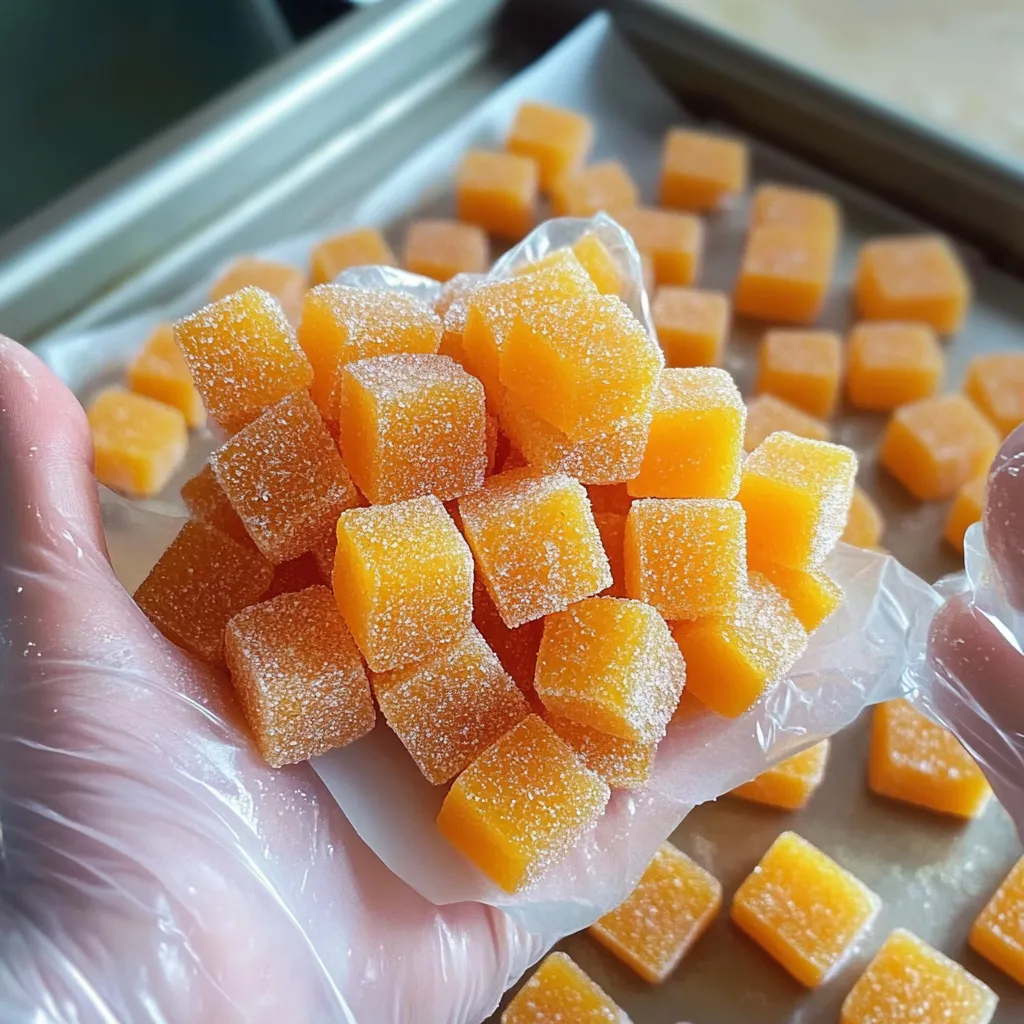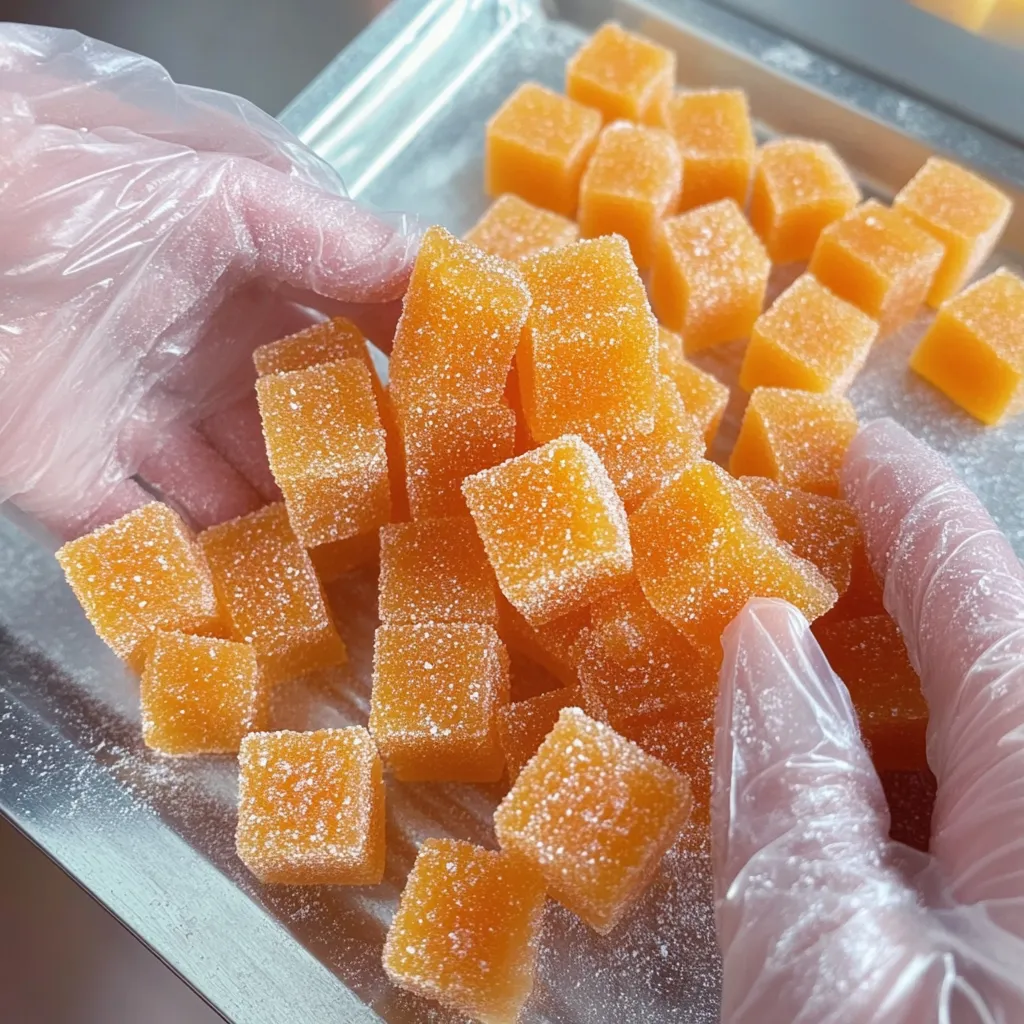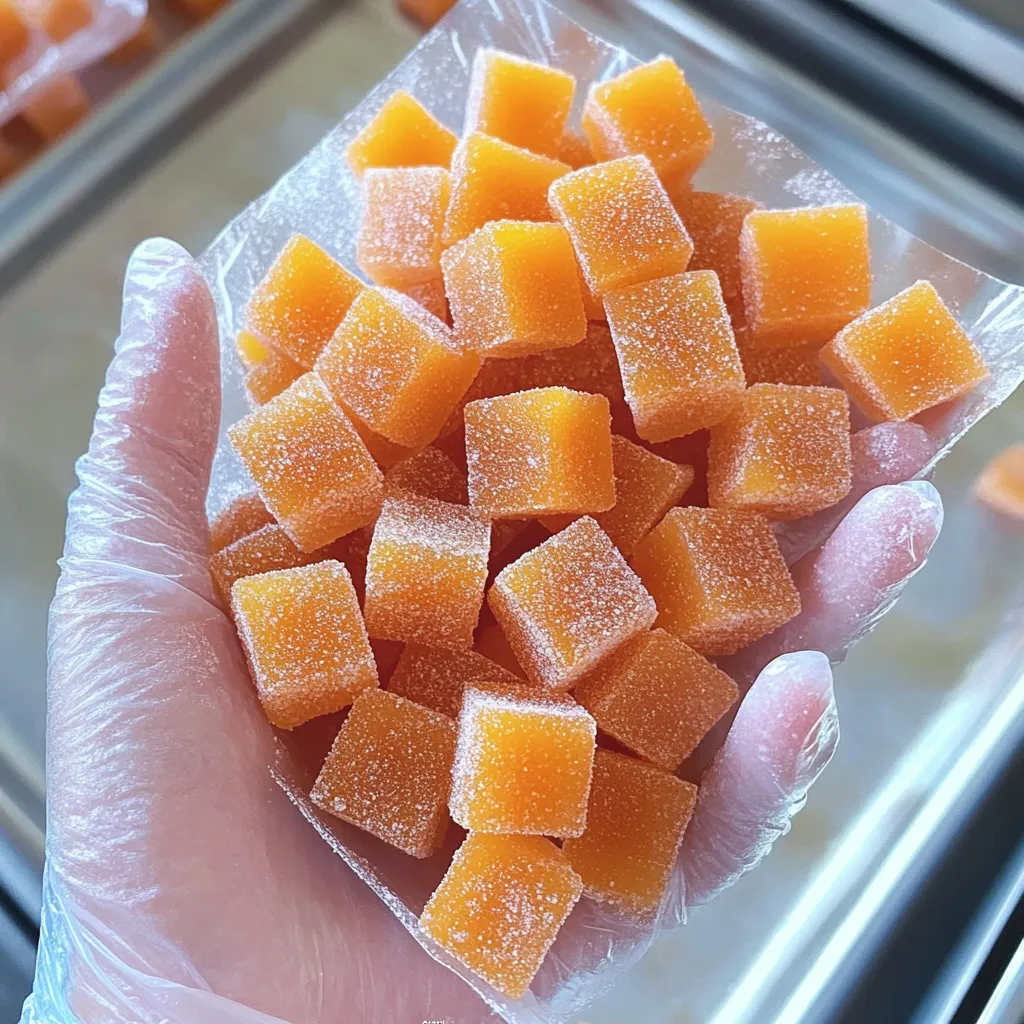 Pin it
Pin it
Chinese mango candy transforms tropical fruits into chewy, jewel-toned treats featuring the perfect marriage of sweet mango and tangy passion fruit wrapped in a silky, butter-enriched texture that melts in your mouth. This homemade confection elevates simple ingredients into sophisticated candies that deliver concentrated fruit flavor without artificial additives or preservatives. I discovered this recipe during a summer exploration of Asian candy-making techniques and have since perfected it through countless batches shared with delighted friends and family.
The first time I served these at a gathering, a friend who had lived in Asia for several years took one bite and declared them "better than the traditional candies I remember from street markets." What delights me most about this recipe is how it transforms everyday fruits into something extraordinary through a process that feels almost magical as the mixture transforms from liquid to glossy confection. Even guests who typically avoid sweets find themselves reaching for seconds of these fruit-forward treats.
Sunny Staples
- Fresh mangoes: Provide the foundation flavor; fully ripened fruits offer superior sweetness and aroma
- Passion fruits: Add essential tang and complexity; select fruits that feel heavy with wrinkled skin for optimal ripeness
- Mizuame or maltose syrup: Creates the distinctive chewy texture; available at Asian markets or substitute with light corn syrup
- Cornstarch: Acts as the primary thickening agent; ensures proper setting and stability
- Butter: Adds richness and smooth mouthfeel; use unsalted for best results
- Granulated sugar: Balances the fruit acids while helping create proper texture
- Parchment paper: Essential for molding and preventing sticking; silicone mats work well too
I learned an important lesson about passion fruit selection during my first attempt at these candies. Using underripe fruits created a weak, watery juice that lacked the necessary acidity to balance the sweet mango. I now select passion fruits with deeply wrinkled purple skin that feel heavy for their size, indicating maximum juice content and optimal ripeness. This seemingly small detail transforms the finished candy from merely good to memorably exceptional.
Candy Craft
- Extract Maximum Flavor:
- Begin by halving ripe passion fruits and scooping the pulp into a fine-mesh sieve positioned over a bowl. Gently press with the back of a spoon to extract the juice while leaving the seeds behind. The seeds contain a bitter outer coating that can compromise the candy's flavor if crushed. For the mango component, select fruits that yield slightly to gentle pressure and emit a sweet aroma at the stem end. Carefully peel and dice the flesh before puréeing until perfectly smooth—any fibrous bits will disrupt the candy's silky texture.
- Create The Perfect Base:
- In a heavy-bottomed saucepan, combine the passion fruit juice, mango purée, sugar, and mizuame (or maltose syrup). Begin heating over low flame while stirring continuously with a silicone spatula that can reach the corners of the pan. The mixture should warm gradually—rushing this step risks scorching the delicate fruit flavors. Meanwhile, prepare a cornstarch slurry by whisking cornstarch and cold water until completely smooth. This suspension must be lump-free to ensure uniform thickening throughout the candy mixture.
- Master The Transformation:
- When the fruit mixture reaches a gentle simmer, slowly pour in the cornstarch slurry while whisking vigorously. The change is immediate and remarkable—what was a thin liquid begins transforming into a glossy, thickened mass. Reduce heat to the absolute minimum and continue stirring. Add butter in small pieces, allowing each addition to fully incorporate before adding more. This patience creates a velvety emulsion that improves both flavor and texture. The mixture is ready when it pulls away slightly from the sides of the pan and falls from the spatula in a slow, glossy ribbon.
- Perfect The Setting Process:
- Line a shallow baking dish with parchment paper, leaving overhang on all sides to facilitate removal. Pour the hot candy mixture into the prepared pan, working quickly before it sets. For professional-looking results, cover with a second sheet of parchment and use a fondant smoother or offset spatula to create a perfectly level surface. Allow the candy to cool completely at room temperature rather than refrigerating, which can create unwanted condensation. The gradual cooling process develops optimal texture—an exercise in patience that rewards with perfect results.
- Finish With Precision:
- Once completely set, use the parchment overhang to lift the candy sheet from the pan. With a sharp knife lightly coated with neutral oil, cut into precise squares or rectangles. For traditional presentation, roll each piece in granulated sugar, which prevents sticking while adding a pleasing crystalline crunch that contrasts with the chewy interior. Store between layers of parchment in an airtight container to maintain freshness and prevent the pieces from fusing together.
 Pin it
Pin it
During a candy-making workshop I hosted, a participant complained that her batch turned out excessively firm and almost tough rather than pleasantly chewy. After troubleshooting together, we discovered she had cooked the mixture at too high a temperature, causing excessive moisture evaporation. I've since learned that maintaining the lowest possible heat during the thickening stage is critical for developing that perfect texture—the mixture should barely simmer rather than actively bubble. Sometimes the gentlest technique makes the most significant difference in the final result.
Serving Suggestions
These versatile candies shine in numerous presentations throughout the year. For elegant dinner parties, arrange them on small porcelain dishes alongside a selection of teas for a sophisticated dessert option. During holiday seasons, wrap individual pieces in waxed paper twisted at the ends and present them in decorative tins as homemade gifts. For children's parties, cut them into fun shapes using small cookie cutters before the candy fully sets. Create a stunning dessert board by arranging these colorful treats alongside fresh fruit slices, dark chocolate, and crystallized ginger.
Creative Variations
While the mango-passion fruit combination creates a perfect balance, this adaptable recipe welcomes thoughtful modifications. Create a tropical variation by substituting pineapple purée for the mango. For a sophisticated twist, add a tablespoon of finely minced crystallized ginger to the mixture before setting. Experiment with citrus versions using blood orange or yuzu juice in place of passion fruit. For special occasions, fold in a teaspoon of edible gold dust just before pouring into the mold, creating shimmering confections worthy of celebration.
Storage Strategy
These candies maintain their quality remarkably well when properly stored. Keep them in a single layer in an airtight container with parchment between layers to prevent sticking. At room temperature in a cool, dry place, they remain delicious for up to two weeks. In humid environments, adding a small packet of food-grade silica gel to the container helps maintain their perfect chewy texture. These treats can also be frozen for up to three months—simply thaw at room temperature before enjoying. Avoid refrigeration, which can cause unwanted moisture to develop on the surface.
I've been perfecting these Chinese mango candies for nearly four years, making subtle adjustments with each batch. What began as an experiment in Asian confectionery has evolved into one of my signature homemade treats—the ones friends specifically request for special occasions. Last Lunar New Year, I packaged these candies in traditional red envelopes for friends, who later told me they rationed their pieces to make them last as long as possible. The beauty of this recipe lies in its ability to transform simple ingredients into something that tastes simultaneously exotic and comforting through patient, attentive preparation.
 Pin it
Pin it
Frequently Asked Questions
- → Can I use frozen mango instead of fresh?
- Yes, just thaw and blend it into a smooth puree first.
- → What can I substitute for mizuame?
- Maltose syrup or light corn syrup works as a replacement.
- → How long do these candies last?
- Store in an airtight container for up to 2 weeks.
- → Can I skip the passion fruit?
- Yes, use all mango puree, but the tanginess adds great flavor.
- → Why is my candy too sticky?
- It may need more cooking time to thicken properly.
